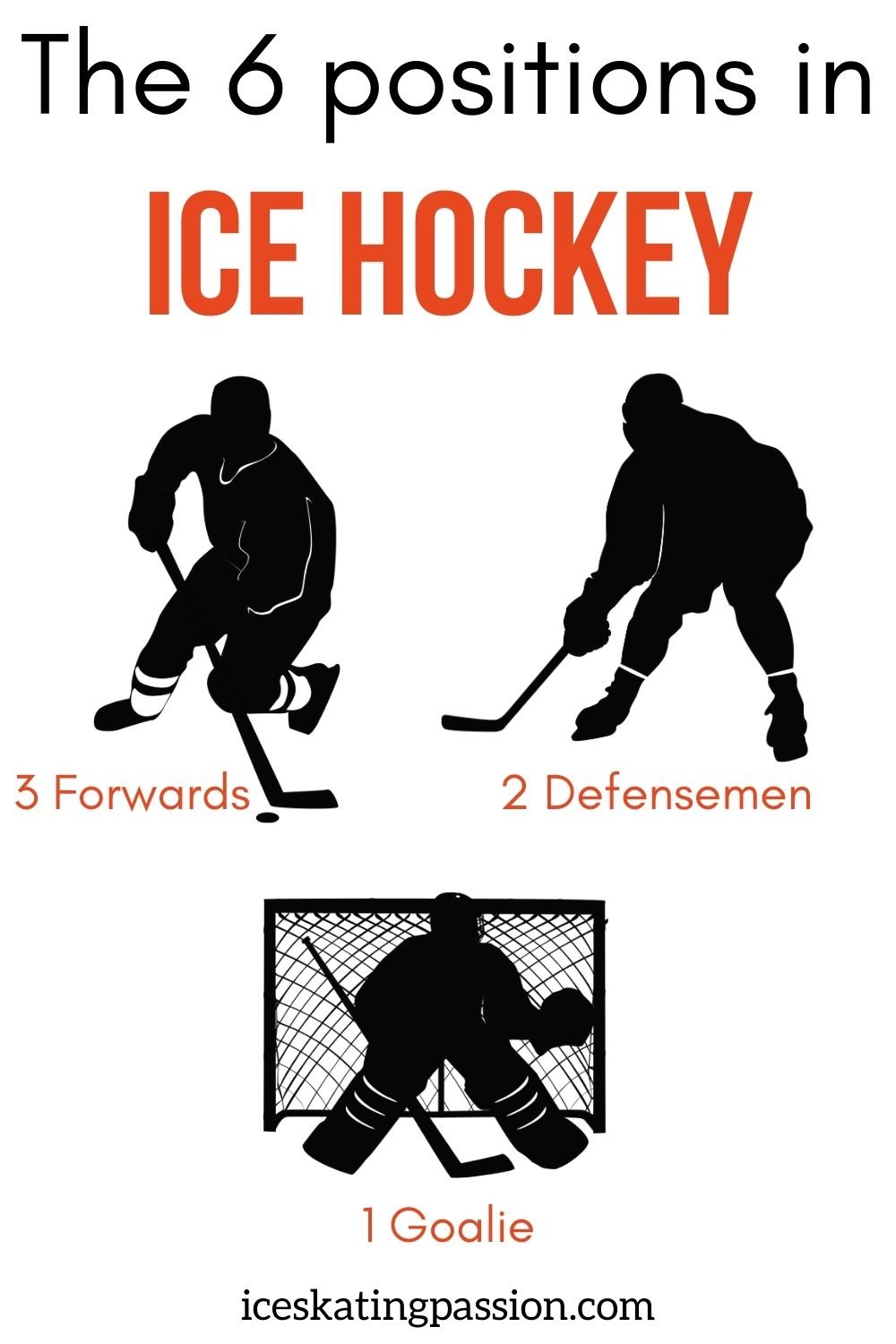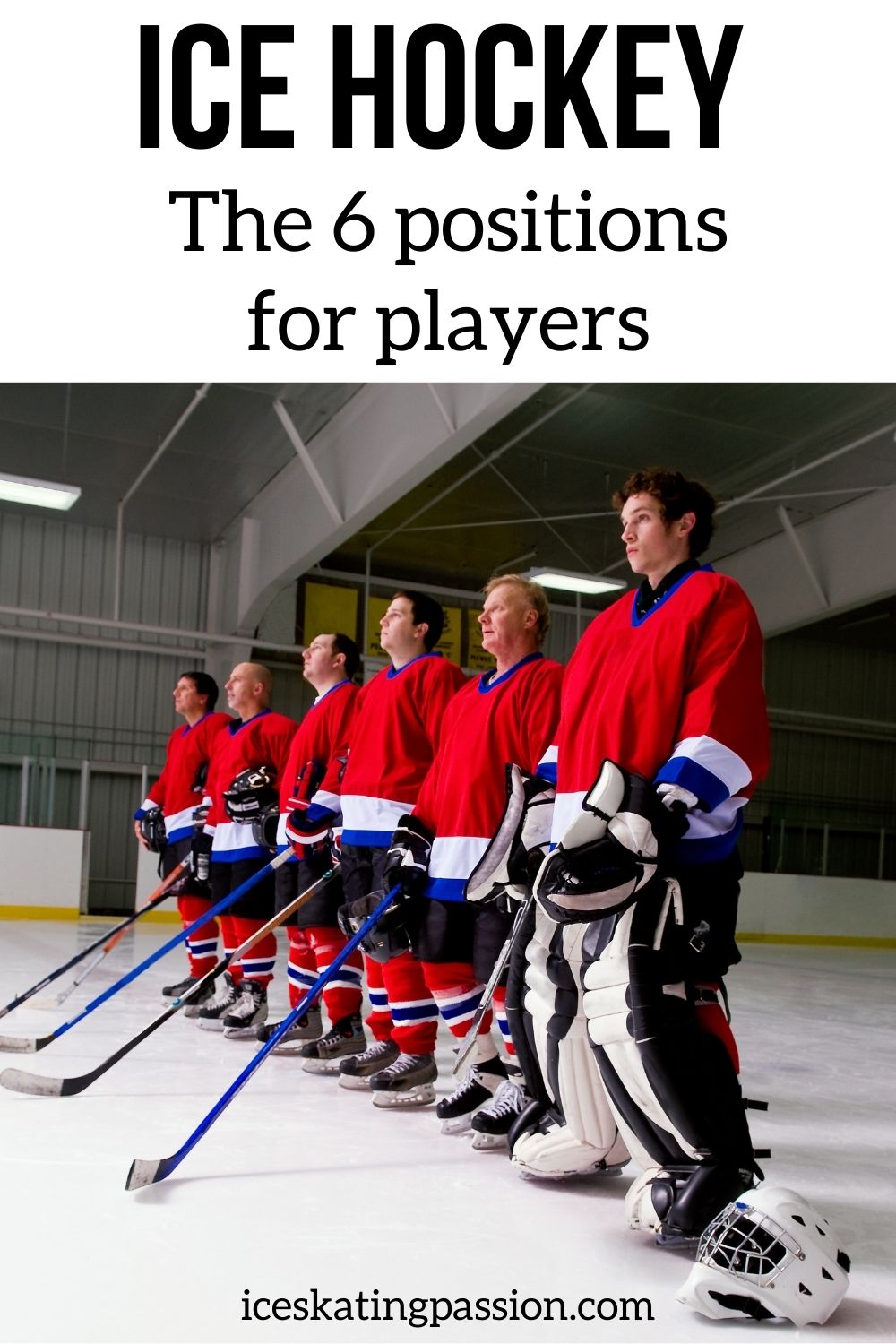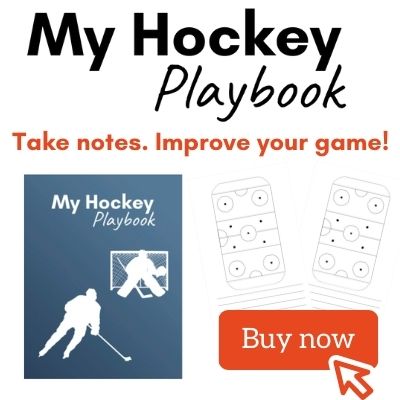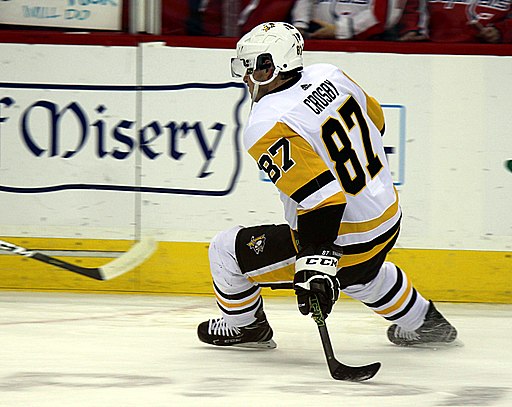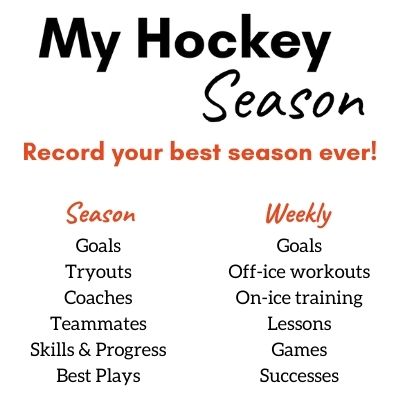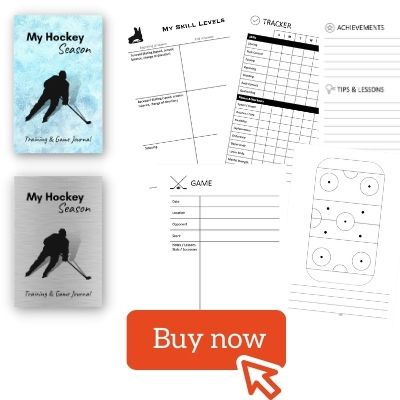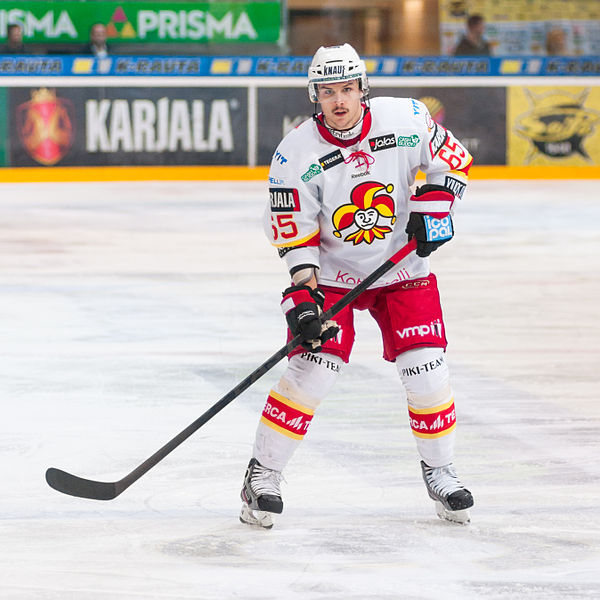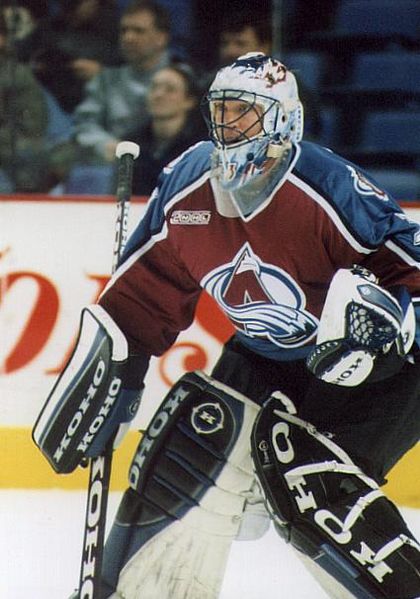Trying to understand the positions in Ice Hockey?
Wondering which position you or your kid should play?
Below is a guide about the ice hockey positions with a diagram and their responsibilities, roles, required skills and famous players.

This article contains affiliate links. If you purchase using my link, I get a commission at no extra cost to you (more info here).
The positions in Ice Hockey - Introduction
What are all the positions in hockey?
There are 3 lines of players in ice hockey:
- The 3 Hockey Forwards - their main objective is to score. There are 3 forwards: Left wing, Center and Right wing
- The 2 Hockey Defensemen - their main objective is to top the opposing team from scoring. There are 2 defensemen: Left and Right
- The Goalie - the Goaltender's objective is to prevent the puck from going in the net. He/she stays near their goal and wears different equipment than the other players.
They initially stand in their allotted position like, defense or forward but then can move anywhere. However, the goalie can't cross the red line.
Unlimited substitutions are allowed anytime.
In this article, I will explain each position in detail: role, skills, body-types, famous players...
Are the hockey positions the same in NHL as other leagues?
Yes, for all leagues the ice hockey positions are the same.
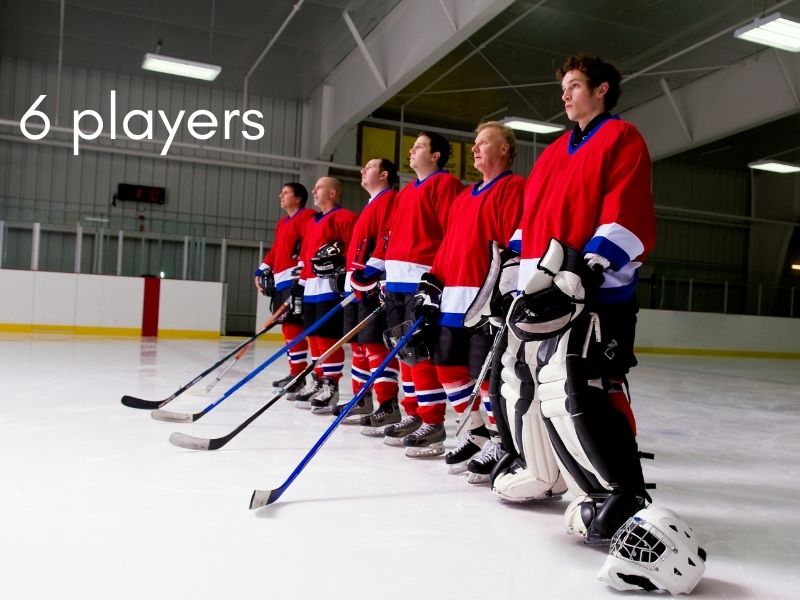
How many hockey players are on the ice? How many on a team?
On the ice at the same time, each team is allowed 6 players.
However, the team members rotate on the ice.
The NHL teams are allowed a total of 23 players. Most team average 20 players dressed for the game with 12 forwards (4 center, 4 left, 4 right), 6 defensemen (3 left and 3 right) and 2 goalies.
In other leagues and recreational hockey, teams are typically smaller (e.g. 9 forwards, 4 defensemen, 1 or 2 goalies).
Ice Hockey Positions Diagram
Below is an image: Diagram for you to better understand the starting positions of each player for both teams:
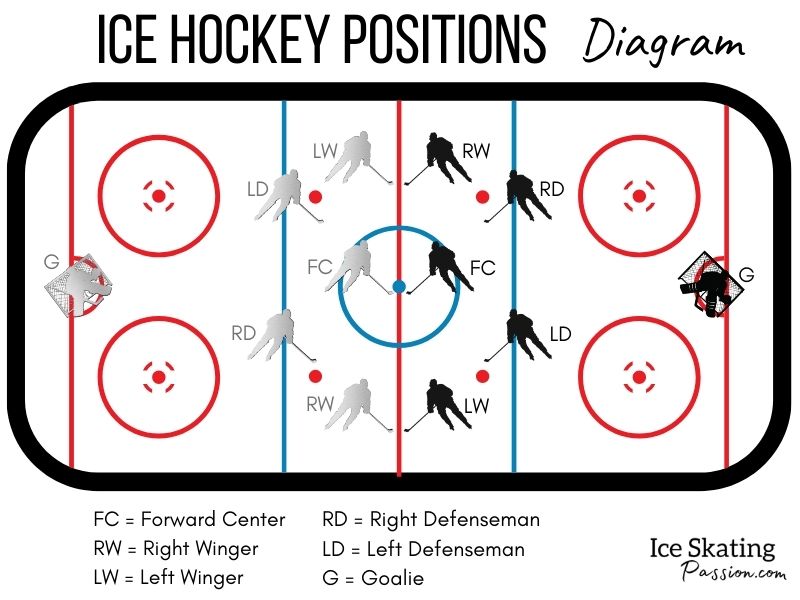
Ice hockey positions explained
In the next sections, I explain into more details the roles and rules applicable for each of those positions.
#1 - Forward Center
Position
The Forward Center is on the offense line in the middle.
Centers have the most ice area to cover: the whole middle of the ice, from the front of their net, to the blue line and to the faceoff dot.
Usual body type
Skills are more important that body types.
Forwards are often shorter than defensemen. However, centers are often bigger than Wingers.
Roles & Responsibilities
The center is often considered as the quarterback of ice hockey.
He normally:
- Must win the face-off to take control of the puck
- Leads the play, most of the time (set up the plays in the offensive zones and makes great passes to the wingers).
- Helps with defense by preventing the other centerman from leading his/her play
Skills
Due to their large area to cover and responsibilities, the skills for centers are mainly:
- Quick on their skates
- Great instincts, play knowledge and creativity
- Great sense / vision of teammates and open spaces
- Great stick handling and passing skills
- Good stamina
Famous players
The NHL draft, a highly skilled center is always the most desirable player.
Some of the most famous players were centers with great passing skills and scoring abilities.
Famous male centers: Wayne Gretzky, Sidney Crosby, Connor McDavid, Nathan MacKinnon.
Famous female centers: Kendall Coyne Schofield (Forward), Natalie Spooner (Forward), Marie-Philip Poulin (Forward)
#2 + #3 - Forward Left and Right Wingers
Position
The left and right wings or wingers have similar roles. They are forwards. They are positioned on the left and right side of the center on the offense line.
While in offense, their area ranges from the center of the faceoff circle to the corner in front of the goalie opposite them.
Their side is often determined by if they are left or right-handed but there are exceptions. Most players prefer having their dominant hand towards the boards closest to them (when facing in offense), to better control the puck.
Usual body type
There are no specific body types. Different physique can bring different advantages: being better at taking hit and keep going or being smaller and faster.
However generally speaking, these are often the positions with smaller players.
Roles & Responsibilities
The main objectives of a winger are:
- finding position where they could get an open shot
- scoring into the opposite team's goals - typically, they are the highest scorers on the team
- making good passes to the center for finding empty spaces
- battling for pucks in the corner and along the boards
- carrying the puck to the offensive zone when passed by the goalie
- trying to intercept passes when in defense
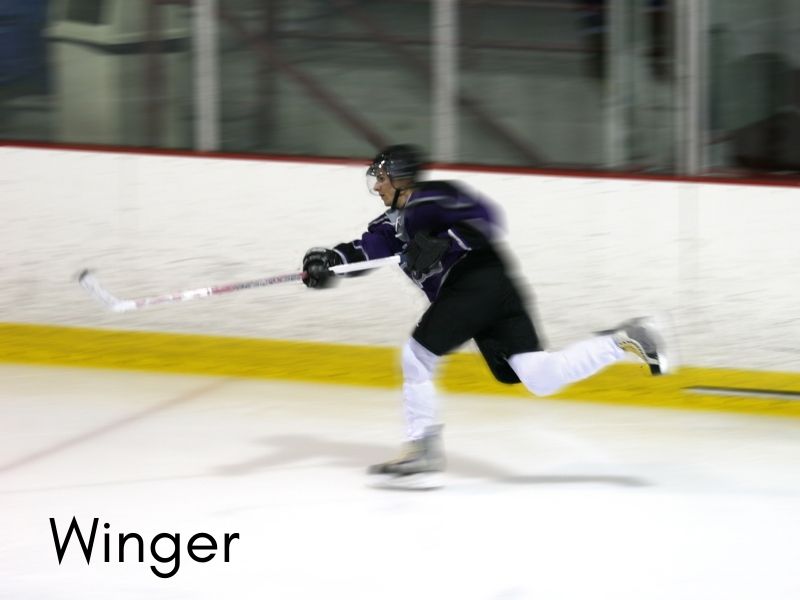
Skills
Based on those responsibilities, the most important skills for a winger are:
- Excellent at wrist shot and slap shot
- Offensive-minded
- Strong puck protection stick handling techniques
- Fast skating
- Great space vision
But this is the position where you can find the greatest variety of player types and skills depending on what the game needs: Grinder, Sniper, Enforcer, Power... (See player types further down in the article)
Famous players
Famous male wingers: Dave Andreychuk, Yvan Cournoyer, Marian Hossa...
Famous female wingers: Cammi Granato (Forward Center/Right), Kendall Coyne Schofield (Forward), Natalie Spooner (Forward), Marie-Philip Poulin (Forward)
#4 + #5 - Left and Right Defensemen
Position
Left and Right Defensemen must work together to create a strong defense.
They are placed between the forward line and the goalie.
The left defensemen lock the left corner of the ice whilst the right defensemen lock the right corner.
In offense mode, they cover their side of the ice on the top of the offense zone (blue line to center).
Usual body type
Defensemen tend to be bigger than the other players on the ice. They benefit from height and long arms.
Roles & Responsibilities
Both defensemen are responsible for helping protect the net by:
- controlling the play when in the defensive zone,
- blocking the forwards from the other team (stick checking...),
- noticing open spaces and covering them,
- intercepting or stopping any shot or pass towards the goal or another forward from the other team,
- upsetting the opposite team's play,
- moving the puck out of the defense zone quickly, to transition to offence.
The defensemen are less involved in offense but are here as a second line to take slap shots and stop the puck from leaving the offensive zone.
Skills
The most important skills of defensemen are:
- Skating, especially backwards - they often are the most skilled skaters
- Ability to read the play of the opposite team and adapt positioning
- Great passers to get the puck back into the offensive zone
- Good at slap shots
Famous players
Famous Defensemen: Bobby Orr, Nicklas Lidstrom, Erik Karlsson
Famous Defensewomen: Jocelyne Larocque, Lee Stecklein
#6 - Hockey Goalie
Position
This one is kind of obvious. LOL.
The goalie is positioned in front of the team's goal. He/she does not move much, mostly staying in front of it.
The goaltender wears different gear than that of the other players to have more protection and to catch the puck (for example, the goalie glove as a net - read more). But he can also personalize this gear, and some goalies are famous for designs on their helmets or overall look.
Usual body type
There are successful goalies with a variety of sizes. Bigger skaters often cover more of the goal with their frame but can be slower or less agile.
However scouts often look for bigger goalies.
Roles & Responsibilities
The main objective of the goalies is to stop pucks from entering the goal, when shot by the opposite team (flying over 100mph in the NHL).
They can use any means possible. They can use any part of their body.
The goaltender is the only player on the ice that does not stop playing and switch with other teammates (unless injured). He/she stays put for the entire game.
Skills
The most important skills for goalies are:
- Quick on their skates - great balance
- Fast lateral movements
- Reflexes
- Strong mental fitness
- Geometrical spacial vision
- Agile and flexible
Famous players
Famous male Goalies: Patrick Roy, Martin Brodeur, Jacques Plante
Famous female Goalies: Shannon Szabados, Maon Rheaume, Noora Raty, Jesse Vetter
Hockey Player Roles / Types
On top of hockey positions, you can also categorize players into different types.
Some types are specific to certain positions, while others can be played by several.
They depend on the skillsets, the body types and where they play.
They mostly are:
- The Playmaker (Forward) -
Best at seeing empty space, leading a play and passing the puck to execute the vision - The Grinder (Forward) -
In offense, a player that charges the net, push and shoves the opposite defensemen. Often gets into fights.
In defense, used as a wrecking ball for killing penalties and blocking shots. - The Power (Forward) -
Often bigger players that tend to battle with the opposing players during puck battles - The Sniper (Forward) -
Often considered the star of the game - best shot expected to score a lot - The Enforcer (Forward or Defense) -
Aggressive type of player whose goal is to annoy, agitate and rough up the other team - The Two-Way (Forward or Defense) -
A player that does not excel at one single thing but is able to manage all that is thrown at him / her, on offense or defense. - The defensive / shutdown defenseman -
An enforcer for the defense - a defensive machine capable of disrupting the other team. - The offensive defenseman -
Best at moving the puck from the defense zone to the offense zone.
Ice Hockey Positions - FAQ
What is the most important position in hockey?
There are only 6 players on the ice, so everyone is important and essential. Some are focused on offense, when others are focused on defense.
The Forward Center is often considered the "top position" by popularity, because he/she often leads the game.
But you cannot win a game with a goalie that let all the goals in, if your defensemen don't block anyone and if your wingers can't score.
What is the most dangerous position in hockey?
Goaltender is the most dangerous position in hockey.
This is the player that is always targeted by the puck and towards whom the puck flies the fastest.
There is a saying: "I am a goalie mom. Nothing scares me".
What is the most difficult position to play in hockey?
Most people agree that the most difficult hockey position is the goaltender. It requires a lot of anticipation, focus and a capacity to get back in the game quickly.
Which ice hockey position scores the most?
Overall, the hockey players scoring the most goals are the Left and Right Wingers.
Which position should I (or my kid) play in hockey?
Don't start playing hockey with a specific position in mind. Your idol may be playing it, but it does not mean you are best suited for it.
New hockey players (children or adults) should try to play in every position as much as possible to familiarize themselves with the positioning and team participation.
All stickhandling skills are transferable to all positions anyway.
Then as the team and players evolve, there will be a situation pattern that will emerge and some players will feel more comfortable and efficient in some positions.
This is often due to:
- Body size - centers and defensemen are typically bigger than the wingers
- Speed - all positions require speed, but the wingers are typically the fastest on their skates (and quick to switch position)
- Passing - Again everyone must be a good passer but centermen are essential in passing the puck to the wingers for scoring
- Shooting - The 3 forwards are normally the best at shooting
- Hockey vision - sometimes a player may not be the best technically but if he/she has a great capacity to notice open space and find the right spaces at the right time, he/she will make a great center.
- Instinct - like for skills, different players might be good at feeling different situations. A player that can feel how the offense is going to play will be great at defense.
Whatever position you end up playing, il will require dedication, hard work and team work to enjoy a great season!
Other articles you might enjoy:
- All you need to know about the puck - read article
- The 12 benefits of playing hockey - read article
- 35 inspirational quotes about ice hockey - read article
- 32+ tips for hockey moms - read article
- Off-ice hockey training - what to work on - read article
- 10 useful off-ice training equipment - read article
You might also be interested in:
